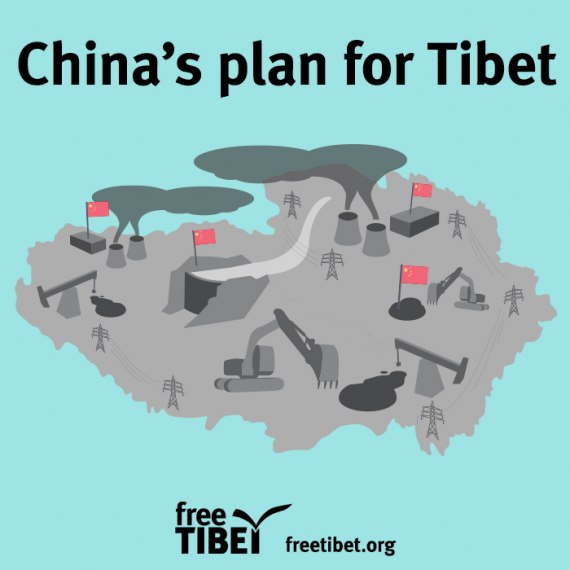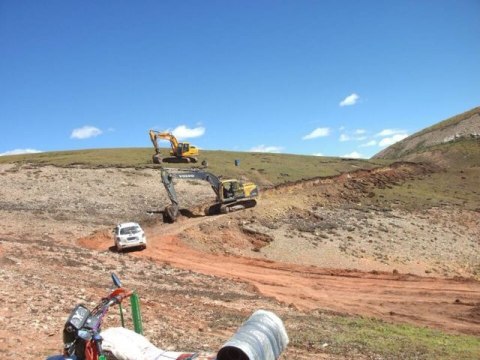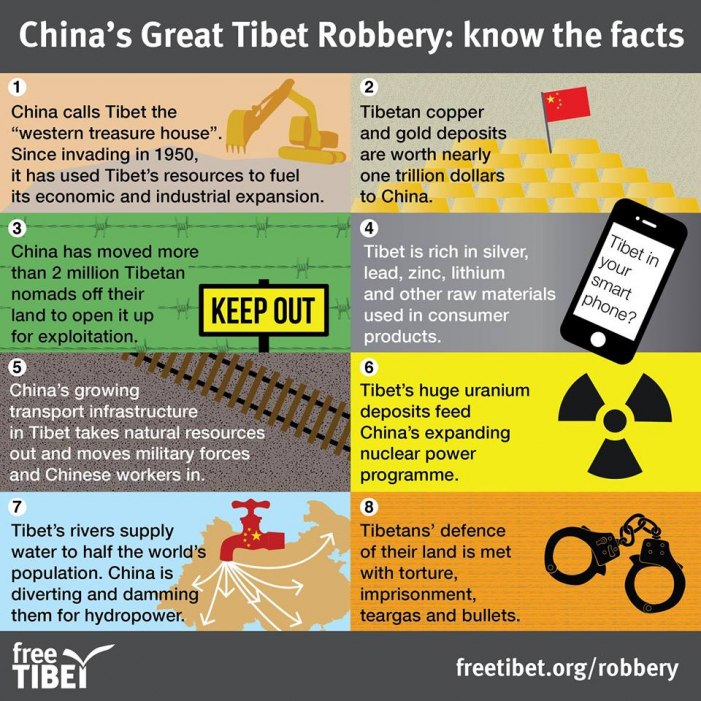RAIDING TIBET’S RESOURCES
 In recent years, China’s exploitation of Tibet’s natural resources has gathered pace significantly. Tibetans have no power to protect their own land and must watch the economic benefits of its resources flow out of their country.
In recent years, China’s exploitation of Tibet’s natural resources has gathered pace significantly. Tibetans have no power to protect their own land and must watch the economic benefits of its resources flow out of their country.
The proliferation of mining and extraction projects across Tibet, backed up by finances from the Chinese government, poses a threat to the population and the environment. Before the Chinese occupation there was almost no industrialisation in Tibet.Chinese industrialisation and extraction has now moved millions of Tibetan nomads from their traditional grasslands to urban settlements, opening their land for the extraction of resources and ending traditional agricultural practices which have sustained and protected the Tibetan environment for centuries.
 In recent years China has paid for the infrastructure to greatly expand its level of extraction in Tibet. The construction of the Qinghai-Tibet railway in 2006 connected Tibet to central and ultimately eastern China, allowing its resources to be transported east with a speed and scale that had not been possible before. Meanwhile networks of roads and power stations have spread across Tibet. By 2016, just ten years after the railway was built, Tibet had close to 100 mining sites spread around the country.
In recent years China has paid for the infrastructure to greatly expand its level of extraction in Tibet. The construction of the Qinghai-Tibet railway in 2006 connected Tibet to central and ultimately eastern China, allowing its resources to be transported east with a speed and scale that had not been possible before. Meanwhile networks of roads and power stations have spread across Tibet. By 2016, just ten years after the railway was built, Tibet had close to 100 mining sites spread around the country. The new infrastructure has also allowed the Chinese government to introduce large numbers of Han Chinese workers into Tibet, emphasising that extraction in Tibet is not solely about resources, but also about creating ‘facts on the ground’ so that self-determination becomes increasingly difficult.
The new infrastructure has also allowed the Chinese government to introduce large numbers of Han Chinese workers into Tibet, emphasising that extraction in Tibet is not solely about resources, but also about creating ‘facts on the ground’ so that self-determination becomes increasingly difficult.
While China’s government is quick to claim that its presence in Tibet has increased prosperity and development, the following case studies demonstrate that China takes much more from Tibet that it gives, and that as it transports Tibetan resources off to Chinese manufacturers, it leaves behind environmental and social destruction.
CASE STUDIES
Coal
China is now the world’s largest consumer of energy, and 70 percent of this energy comes from coal. To match this need, and due to heavy pollution in its eastern cities, China has shifted many of its mining operations to Tibet.
The results on Tibet’s environment have been devastating. Mining consuming vast quantities of water, while the waste it generates makes water in neighbouring Tibetan communities undrinkable. Coal mines have also been built on land used by farmers for grazing and even in nature reserves.
Copper
China is the world’s largest producer of copper, and nearly one sixth of its copper reserves are in Tibet, with reserves of up to 13 million tonnes of copper in the Tibet Autonoumous Region alone. Car manufacturers based in central Chinese cities such as Chengdu and Chongqing rely on copper from Tibet, which is also used for transmitting ultra-high voltage electricity across China.
Copper mines such as Shetongmon are located near to key rivers, which risk being contaminated by the waste tailings generated by mining.
Gold
Despite being absent from official Chinese statistics, gold continues to be mined in Tibet, either through the dredging of riverbeds – illegal under China’s own laws – or through mining gold deposits. This mining has destroyed land considered sacred by many Tibetans and generated waste that pollutes rivers.
Tibetans have protested against gold extraction, leading to arrests and violence by police and security forces.
Lithium
Lithium is found in batteries in numerous consumer goods produced in China. Several Chinese companies use lithium from Tibet, including the electric car manufacturer BYD, which has been granted a 20 year lease to exploit Tibet’s Chabyer Tsaka Lake by the Chinese government.
Elesewhere in Tibet, toxic chemicals used to extract lithium have leaked into Tibet’s rivers and polluted the air and soil, damaging Tibetan agriculture and killing fish and livestock.
Water (bottled)
Tibet’s is also being exploited by a new craze for bottled water, with numerous bottling companies seeking to gather Tibet’s water at a low cost and then market it to consumers as “pure” Himalayan water.
This water bottling takes place among Tibet’s glaciers, which are shrinking faster than those of anywhere else in the world. Water is even being bottled from national parks and protected areas.
Water (dams)
The Chinese government is constructing dams to generate hydroelectric power and to divert water from Tibet to north and west China in an effort to supply over 300 million people. Construction of these dams has resulted in communities being forcibly relocated.
China’s plans to divert Tibet’s rivers also affect people outside of Tibet and China. Water from Tibet’s rivers is drunk by about 1 billion people throughout Asia every day. Control over Tibet’s rivers gives China a significant geostrategic advantage over its neighbours.
TIBET’S RESISTANCE
Deprived of their land, cut off from their water supply, Tibetans continue to bear the costs of China’s extraction. They also have no way to voice their concerns about the damage caused without fear of arrest or persecution. Tibetans nevertheless protest regularly, carrying out demonstrations and camping on land earmarked for extraction projects. These protests are met with arrests and excessive force by police and security services, who often use batons, tear gas and even live fire to disperse protesters.
CAN YOU SHARE THE FACTS ABOUT TIBET’S ENVIRONMENT?
source:https://www.freetibet.org/resources


comment 0